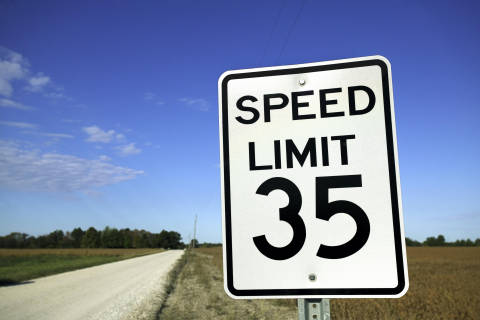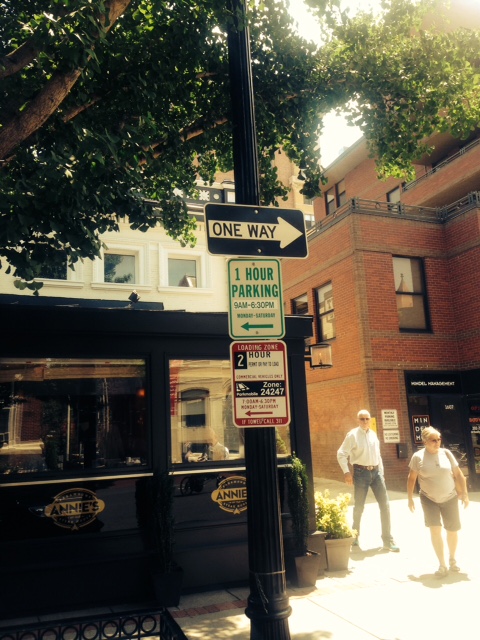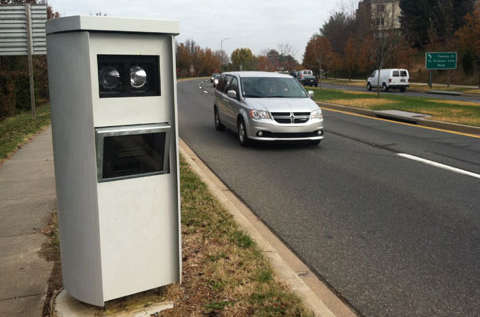GAITHERSBURG, Md. – Red-light cameras are common in Maryland, Virginia and D.C., but many drivers complained to WTOP Ticketbuster about a specific kind of ticket in 2013.
These tickets occur when drivers make a right turn on red, but engage in a specific type of turn that is considered illegal. Known as a rolling right turn or sometimes referred to as a “Rhode Island roll” or “California stop,” these drivers are not coming to a complete stop before making a right turn at a red light.
“The law is very clear,” says Montgomery County Police Captain Thomas Didone, who runs the speed and red light camera program. “In Maryland, upon approaching a red traffic signal, you must stop, complete cessation of movement behind the white stop line. Then, after looking to see if it’s clear, you may proceed on a right turn.”
Maryland Annotated Code §21-202 is the law that deals with the issue, allowing for drivers to make a right turn only after “stopping at the near side of the intersection, at a clearly marked stop line; if there is no clearly marked stop line, before entering any crosswalk; or if there is no crosswalk, before entering the intersection.”
D.C. Municipal Regulation §18-4013 also tells drivers that right turns at red lights are only allowed “after coming to a full stop and yielding right-of-way to pedestrians and other vehicles.”
Virginia Code § 46.2-835 tells drivers, “vehicular traffic facing a steady red circular signal, after coming to a full stop, may cautiously enter the intersection and make a right turn.”
WTOP Ticketbuster has several videos that demonstrate this kind of rolling stop.
“What happens frequently is that when you look at video, people don’t stop,”
Didone says. “They don’t come close to stopping. Maybe in their mind they perceive
they stopped, but the video doesn’t lie.”
In June, a driver in Rockville sent WTOP an email about a red light camera ticket at Seven Locks Road and Fortune Terrace. As WTOP reported in early 2013, the City of Rockville strictly interprets Maryland law on the issue. But according to the video, the driver never came to a complete stop.
Another driver told WTOP Ticketbuster about a ticket he received on Washington Boulevard at Lee Highway in Arlington.
“As you can see from the attached ticket, [my wife] was clearly making a right turn,” the driver writes. “Is there anything we can do to avoid court time and getting the ticket dismissed?”
The video also shows she did not stop before making the right turn.
Finally, WTOP Ticketbuster we received an email from a driver who received a red light camera ticket at 12th Street and Constitution Avenue NW in February 2013.
“If you look clearly at the picture, you will notice two things,” this reader says. “First, I stopped at the red light behind the line before making a right turn. Second, there is not a ‘no turn on red’ sign anywhere. They are asking me now to pay $300 for the red light infraction because they claim I never responded. Please help!” But the driver stopped after the crosswalk with half his vehicle in the intersection, then made the right turn.
All three cases show drivers who believe they made a legal turn, but broke the
strict letter of the law.
“Even if you stop over the line and even if you stop halfway into the intersection, according to Maryland law, you’re eligible to a ticket,” Didone says. “Some jurisdictions enforce the strict letter of the law. Others use discretion, like we do in Montgomery County.”
“In Montgomery County, we’re looking to enforce people who disregard red lights,” he says. “If you don’t make a viable attempt to stop, then you’re eligible for a ticket. We give our approvers some extra discretion, so if it appears they attempted to stop, or they stopped in the middle of the turn, the approvers can void the citation. But if the person clearly disregarded the red light, then they issued the ticket.”
Is it really unsafe?
Several motorist groups and camera opponents are skeptical of these types of tickets, arguing that the rolling right turn on red does not pose a significant traffic safety impact.
“Slowing moving right turns on red are extremely unlikely to cause accidents,” Ron Ely of the Maryland Drivers Alliance wrote in September 2012. “One study showed that an average motorist could drive a billion miles, the distance from Earth to Jupiter and back, before being involved in a deadly accident that resulted from a motorist making a rolling stop on a right-hand turn.”
Out of 6.3 million crashes nationwide in 1998, less than 0.04 percent of them involved a driver making a right turn at a red light, according to a 2001 National Highway Traffic Safety Administration study. The report also found no fatalities occurred that year from an accident resulting from a right hand turn on red when the driver yielded to oncoming traffic.
A NHTSA study in 1995 also studied the issue and found similar results.
“Approximately 84 fatal crashes occurred per year during the 1982-1992 time period involving a right-turning vehicle at an intersection where right turn on red (ROTR) is permitted,” the report says. “During this same time period, there were 485,104 fatalities. Less than 0.2 percent of all fatalities involved a right-turning vehicle maneuver at an intersection where ROTR is permitted.
However, [the data] does not discern whether the traffic signal was red. Therefore, the actual number of fatal RTOR crashes is somewhere between zero and 84 and may be closer to zero than 84.”
A Texas A&M Transportation Institute study in 2004 also concluded that accidents from these turns are exceedingly rare and do not pose a serious traffic safety risk.
Groups like the National Motorist Association and Safer Streets LA argue that these rolling right turn tickets are not about safety, but money.
Rockville City Police disagree and say their strict enforcement is the correct
approach.
“The drivers’ past behaviors were inappropriate,” Maj. Michael England of Rockville City Police, told WTOP last March. “They weren’t coming to a full and complete stop before making a right turn, as required under the law.”
He tells WTOP that tickets aren’t issued unless the driver was going above 13 mph into the turn, which he believes can be dangerous to other drivers and pedestrians nearby.









